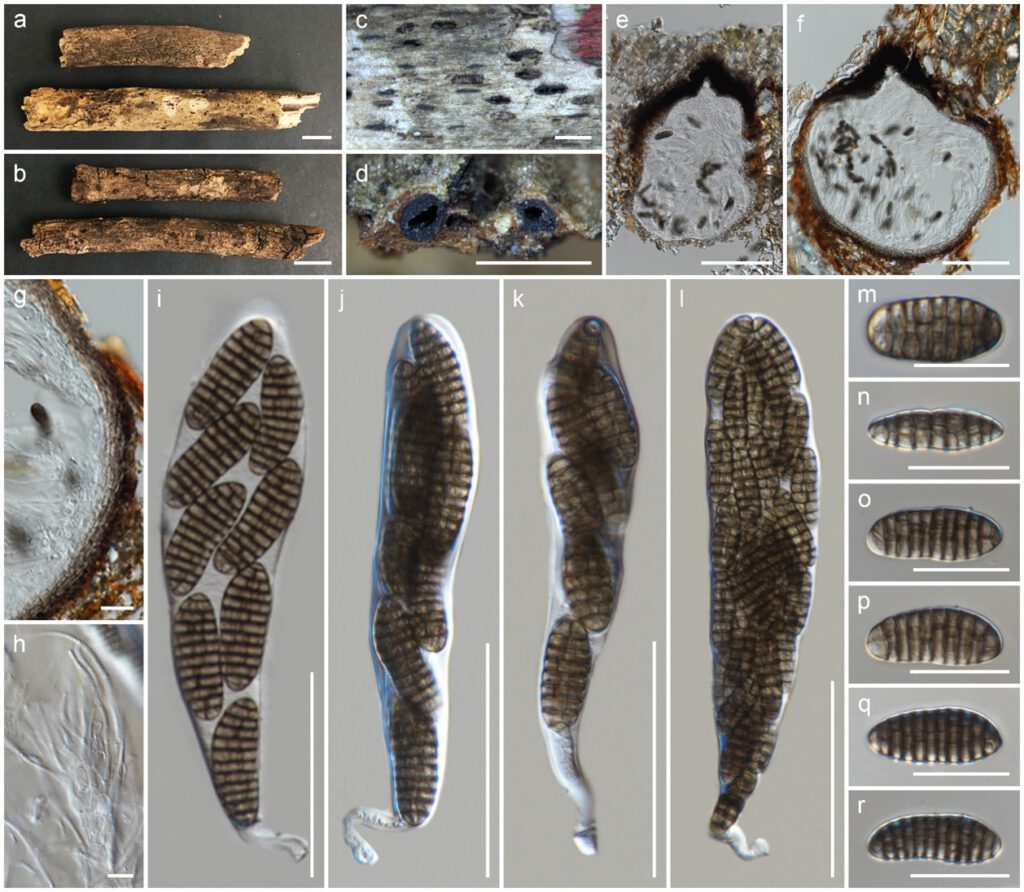Phaeoseptum thailandicum Samarak. & K.D. Hyde in Jayawardena et al., Fungal Diversity 117, 45 (2023)
Index Fungorum number: IF 559754; Facesoffungi number: FoF 11798; Fig. 1
Etymology: The specific epithet reflects the name of Thailand, where the species was collected.
Holotypus: MFLU 19-2136.
Saprobic on dead branches in terrestrial habitats. Sexual morph: Ascomata 270–350 μm high, 160–305 μm diam. (x̅ = 309 × 230.3 µm, n = 10), scattered to gregarious, fully immersed under a small blackened pseudoclypeus, if appearing as black, elongated regions on host surface 540–915 μm (x̅ = 640 µm, n = 8) length; ascomata depressed spherical, laterally flattened. Pseudoclypeus composed of host cells with black deposits. Peridium 6–22 µm (x̅ = 640 µm, n = 8) wide, pseudoparenchymatous, of thin-walled cells, at apex comprising isodiametric angular cells that are more pigmented outwardly, at sides with flattened hyaline cells, at base of angular pigmented cells. Hamathecium comprising 1.4–2.5 μm (x̅ = 1.9 µm, n = 20), wide septate, cellular pseudoparaphyses, situated between and above the asci, embedded in a gelatinous matrix. Asci 100–155 × 20–28.5 μm (x̅ = 129 × 23.9 μm, n = 25), 8-spored, rarely 32-spored, bitunicate, fissitunicate, cylindrical-clavate, with a distinct pedicel, apically rounded with a minute ocular chamber. Ascospores 25–35 × 8–11.8 μm (x̅ = 30 × 9.9 μm, n = 30), uniseriate at base and overlapping 2–3-seriate at apex, pale to dark brown, broadly fusoid with broadly rounded ends, slightly curved, 11 (9–12-transversally septate, with a vertical septum in nearly all median cells, not constricted at the septa, the septa partly pale brown, having at maturity a thickened and heavily pigmented appearance, wall smooth, without sheath or appendages. Asexual morph: Undetermined.
Material examined: Thailand, Nan, Pua District, on an unidentified dicotyledonous dead branch, 29 January 2019, MC Samarakoon (SAMC216), (MFLU 19-2136, holotype; HKAS 106993, isotype), Phrae, an on unidentified dicotyledonous dead branch, 24 January 2019, MC Samarakoon (SAMC203), (MFLU 19–2126; HKAS 106983, paratypes).
GenBank numbers: MFLU 19-2126 – OM293748 (ITS), OM293743 (LSU), OM293754 (SSU), OM305061 (TEF1), OM305067 (TUB2)
MFLU 19-2136 – OM293749 (ITS), OM293744 (LSU), OM305056 (RPB2), OM293755 (SSU), OM305062 (TEF1), OM305068 (TUB2)
HKAS 106993 – OM293750 (ITS), OM293745 (LSU), OM305057 (RPB2), OM293756 (SSU), OM305063 (TEF1), OM305069 (TUB2)
Notes: Our two new collections of Phaeoseptum thailandicum share similar morphology of Phaeoseptum in having immersed ascomata under a small blackened pseudoclypeus, cylindrical-clavate asci with a distinct pedicel and broadly fusoid, brown ascospores with multi-transverse septa. Combined phylogeny shows that the novel taxon is sister to P. mali + P. manglicola clade with high statistical support (Fig. 1).

Fig. 1 Phaeoseptum thailandicum (MFLU 19-2136 holotype) a,b Substarte, c,d Appearance of ascomata on the host, e,f Vertical section through ascoma, g Peridium, h Pseudoparaphyses, i–l Asci, m–r Ascospores. Scale bars: a,b = 1 cm, c,d = 1000 μm, e,f = 15 μm, e, f = 10 μm, g-i = 5 μm.
